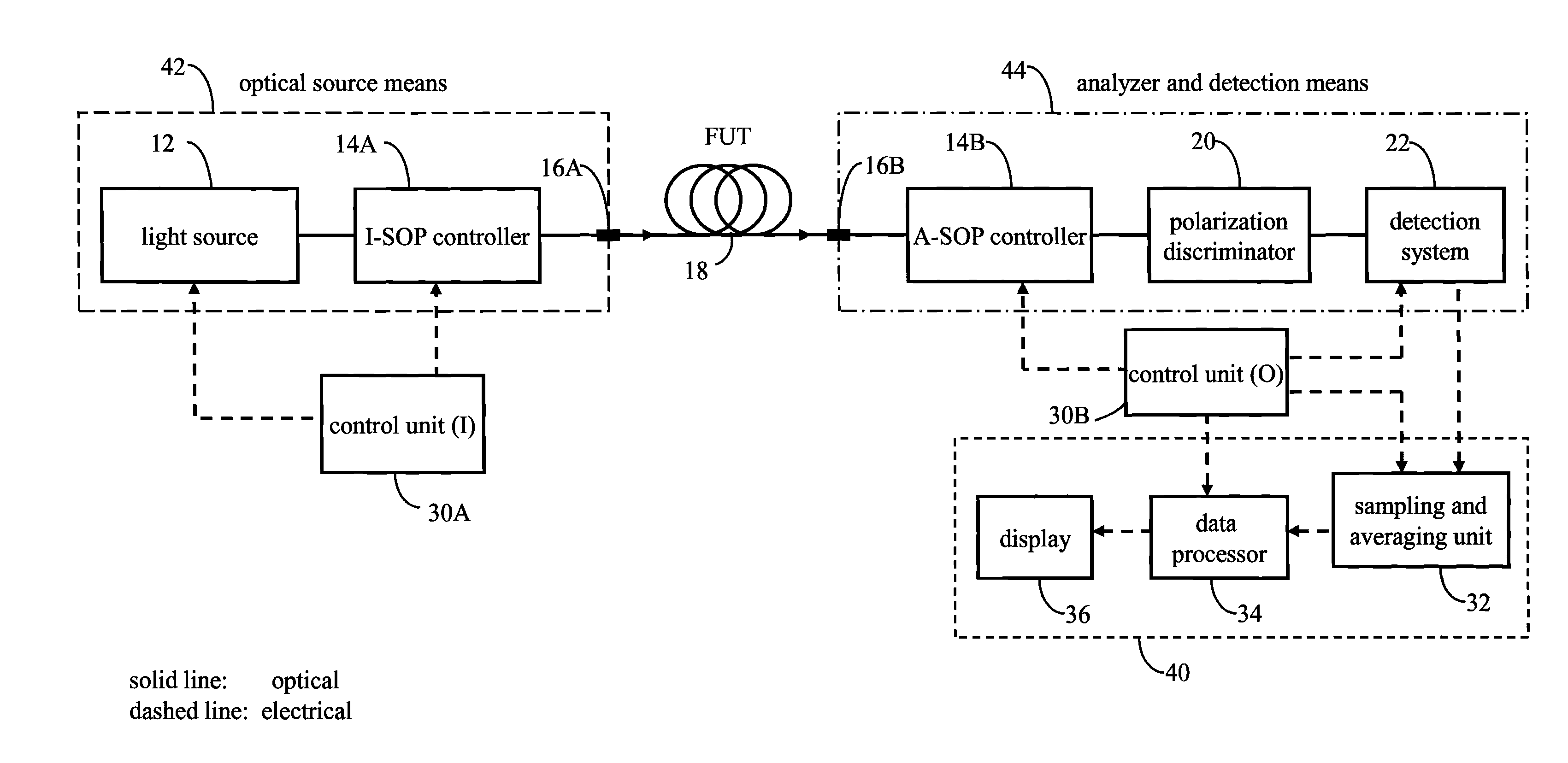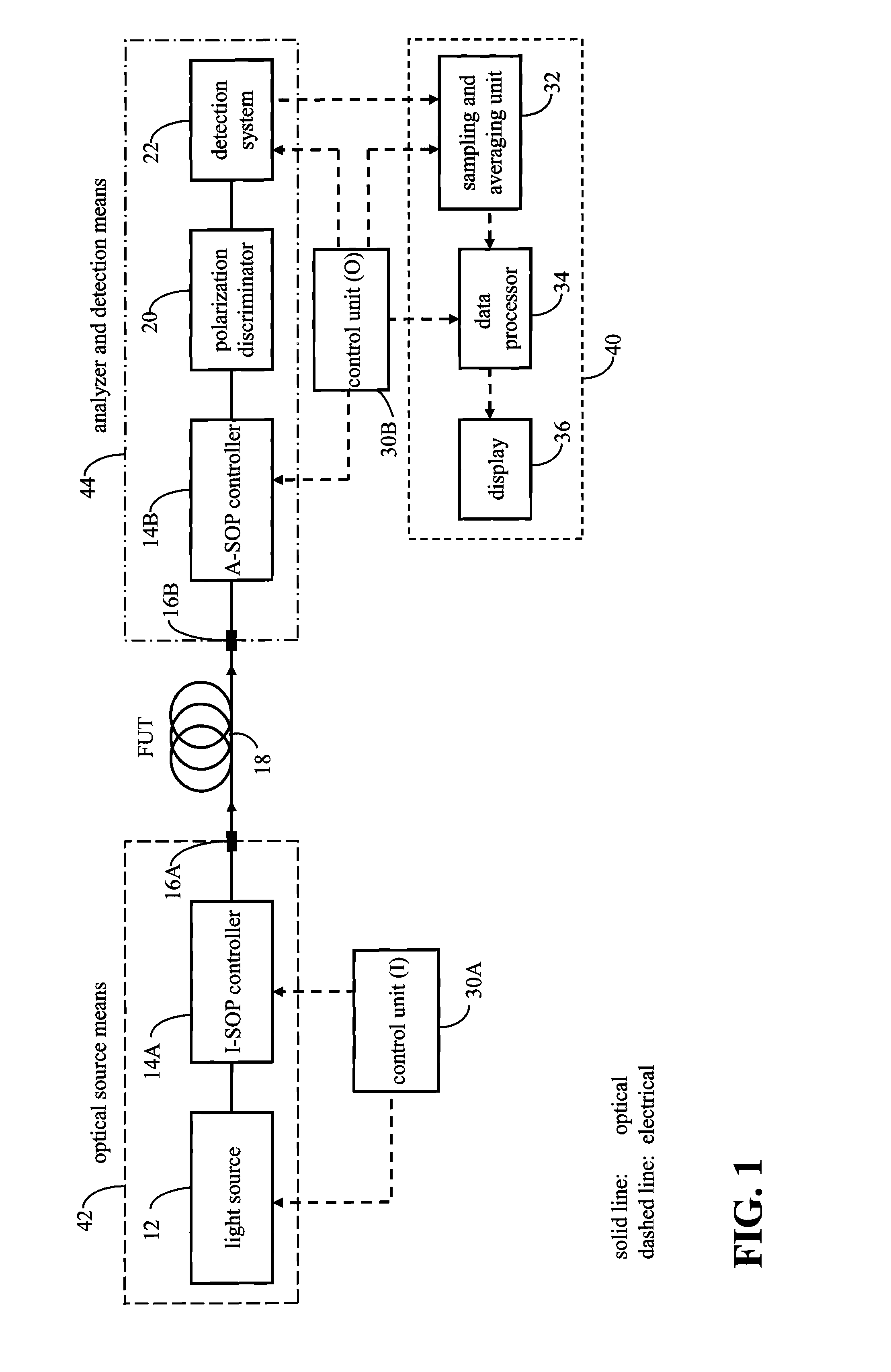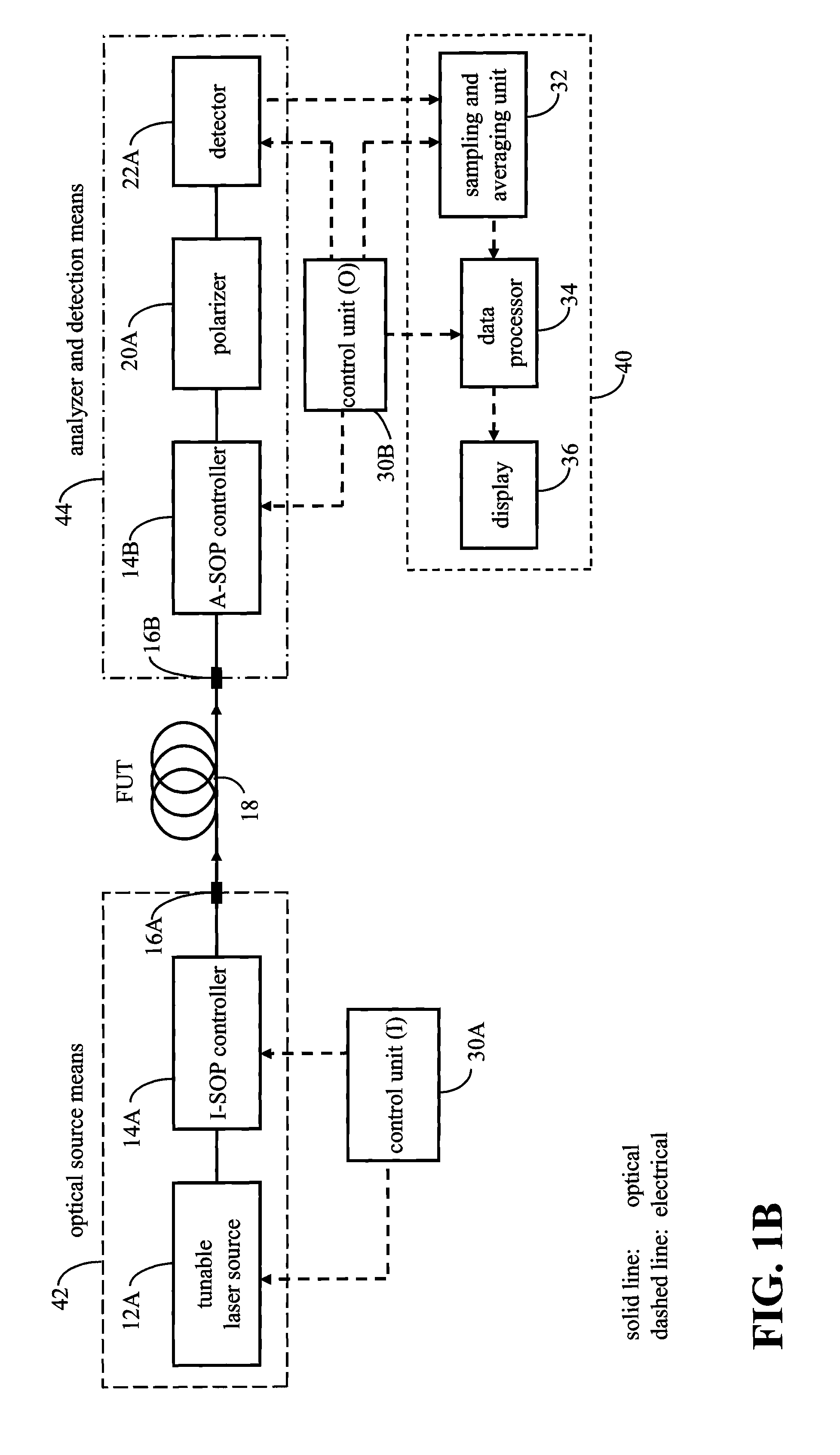This is particularly problematical at higher bit rates.
However, in many cases, it is not possible to measure the DGD at a given wavelength or average DGD over a wide
wavelength range, and hence it is not possible to obtain a reliable determination of the PMD from a measurement taken at a given moment.
However, the method as described is inherently slow, as it entails maximizing the measured phase-shift difference by adjustment of polarization controllers, and is hence not suitable for outside-
plant applications where fibers may be subject to relatively rapid movement.
However, this technique not only requires a high-speed
electronics detection
system but also involves rapidly-modulated light for the measurement.
However, they do not permit determination of the in-channel DGD or “PMD” value of the link.
However, again this measurement may only give DOP or SOP information.
784-793[10]), but it will complicate the design of the instrument.
Its sensitivity to the ASE etc. is an important issue because most long
fiber links are likely to use optical amplifiers, either EDFAs (
erbium-doped
fiber amplifiers) or Raman optical amplifiers.
Moreover, the DGD range measurable using the SOP or DOP
analysis method is limited.
It provides limited accuracy for small PMD values even when a large
wavelength range is used or for measuring PMD using small wavelength range.
Moreover, it may not provide wavelength-dependent DGD information.
Consequently, it is also unsuitable for measurement of
narrowband channels.
794-805 and U.S. Pat. No. 7,227,645[2,3], the latter commonly owned with the present invention, provides accurate PMD measurement (corresponding to the
spectral width of the
broadband source), but is also unable to provide the DGD as a function of wavelength, and is not well suited for use in a
narrowband channel.
Thus, currently potentially-available DGD or PMD measurement techniques adapted to measure DGD or PMD in a narrow-band individual channel of a DWDM systems will be either inherently expensive, be unreliable, have a limited
dynamic range, or may introduce instabilities in rapid
gain equalizers that are often found with reconfigurable optical add-drop multiplexers (ROADMs) and optical amplifiers.
Thus, their realization as a viable commercial instrument is difficult.
Although single-ended PMD measurement concepts and approaches have been put forward previously, their realization as a viable commercial instrument for single-ended PMD measurement is difficult.
This difficulty arises because test and measurement instruments based on such concepts will either be not very reliable, or be very expensive, or have a long
acquisition time, or require the
fiber to be very stable over long periods (i.e. not robust), or have a very limited
dynamic range.
As is also the case with the conventional fixed-analyzer method [13,15], any fiber movement will affect the number of extrema (i.e. maxima and minima) so that it may wrongly estimate the PMD value.
Any power variation in backreflected light from the FUT for the single-ended version of the fixed-analyzer method may also result in wrong estimates of DGD (or PMD).
Unfortunately, such stability of the FUT throughout the time period over which all of the data are measured cannot be assured, especially where the DGD / PMD of an installed fiber is being measured.
Also, a fixed analyzer method as described in references [13,15] not only entails a strict requirement to
restrict fiber movement, but also has one major potential drawback with respect to
measurement reliability because the method measures fiber absolute loss only (not a normalized light power or transmission) using only one
detector without considering other potential factors, such as fiber spectral attenuation, spectral loss of related components used for an instrument, or wavelength dependent
gain of the
detector.
For example, if spectral attenuation of fibers is not taken into account, error or uncertainty in the measurement results may be introduced, especially for fibers having significant
spectral variation (versus wavelength) as is often observed with older fiber cables.
In addition, among those known techniques using a CW
light source, whether a
broadband source or a
tunable laser [12,13,17], the measured results may not be reliable because the backreflected light may comprise a significant contribution from
Rayleigh backscattering, as well as any spurious localized reflections from connectors, etc. not located at the distal end of the FUT.
The Rayleigh contribution grows significantly with fiber length whereas the reflected
light intensity from the localized reflection(s) (such as Fresnel reflection at the distal end of FUT) decreases with fiber length, thus rendering a CW-light-source method impractical for the multi-kilometer FUT lengths of interest in most
telecommunications applications.
Hence, although presently-known techniques meeting the above-mentioned requirements may permit a reasonably successful measurement of DGD / PMD to be made, at present their scope of application and performance would be insufficient for a commercially-viable, stand-alone instrument.
Thus, known techniques and instruments, as discussed, for example, in references [12-17], cannot readily be adapted to develop a robust, reliable and cost effective commercial single-ended PMD test and measurement instrument.
To measure total or overall PMD accurately from only one end of a fiber link, currently available techniques and concepts reported in the literature have significant limitations as described above.
Accordingly, Leblanc discloses a method of measuring distributed PMD which uses a polarization OTDR, to identify high or low PMD fiber sections, but does not provide a real quantitative PMD value for the FUT.
Consequently, because of its inherently “qualitative” nature, Leblanc's technique is not entirely suitable for development as a commercial single-ended overall PMD testing instrument that may measure the total PMD value for the entire of fiber link.
A general limitation of techniques of this first type, therefore, is that they do not provide a direct, reliable, valid in all cases and quantitative measurement of PMD with respect to distance along the optical fiber.
Notably, correct measurement of modern “spun fibers” already requires assumptions to be made about their behavior, and consequently is not acceptable for a commercial instrument.
Furthermore, they are incapable of inferring, even approximately, the overall PMD of a long length of fiber, such as for example 10 kilometers.
However, this technique also suffers from the fundamental limitations associated with this type, as mentioned above.
Unfortunately, such stability cannot be assured, especially where an installed fiber is being measured.
Unfortunately, practical OTDRs do not have a useful
dynamic range with such short pulses.
On the other hand, if a long light pulse is used, only fibers having long beat lengths can be measured, which limits these techniques, overall, to measurement of short distances and / or with long measurement times, or to fibers with large beat length (typically small PMD coefficient).
Hence, although it might be possible, using known techniques and meeting the above-mentioned requirements, to make a reasonably successful measurement of PMD, at present their scope of application and performance would be insufficient for a commercially-viable, stand-alone instrument.
In addition, the use of short pulses exacerbates
signal-to-
noise ratio (SNR) problems due to so-called coherence
noise that superimposes on OTDR traces and is large when short pulses are used.
With a coherent source such as a
narrowband laser, as used in POTDR applications, there is interference between the different backscattering sources.
It can be decreased by increasing the equivalent
laser linewidth, i.e., the intrinsic
laser linewidth as such, or, possibly, by using “dithering” or averaging traces over wavelength, but this reduces the maximum measurable PMD and hence may also limit the maximum length that can be measured, since PMD increases with increasing length.
 Login to View More
Login to View More  Login to View More
Login to View More 


